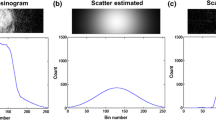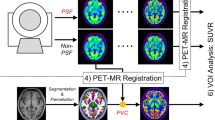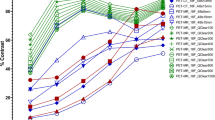Abstract
Objective
A modified version of row-action maximum likelihood algorithm (RAMLA) using a ‘subset-dependent’ relaxation parameter for noise suppression, or dynamic RAMLA (DRAMA), has been proposed. The aim of this study was to assess the capability of DRAMA reconstruction for quantitative 15O brain positron emission tomography (PET).
Methods
Seventeen healthy volunteers were studied using a 3D PET scanner. The PET study included 3 sequential PET scans for C15O, 15O2 and H 152 O. First, the number of main iterations (N it) in DRAMA was optimized in relation to image convergence and statistical image noise. To estimate the statistical variance of reconstructed images on a pixel-by-pixel basis, a sinogram bootstrap method was applied using list-mode PET data. Once the optimal N it was determined, statistical image noise and quantitative parameters, i.e., cerebral blood flow (CBF), cerebral blood volume (CBV), cerebral metabolic rate of oxygen (CMRO2) and oxygen extraction fraction (OEF) were compared between DRAMA and conventional FBP. DRAMA images were post-filtered so that their spatial resolutions were matched with FBP images with a 6-mm FWHM Gaussian filter.
Results
Based on the count recovery data, N it = 3 was determined as an optimal parameter for 15O PET data. The sinogram bootstrap analysis revealed that DRAMA reconstruction resulted in less statistical noise, especially in a low-activity region compared to FBP. Agreement of quantitative values between FBP and DRAMA was excellent. For DRAMA images, average gray matter values of CBF, CBV, CMRO2 and OEF were 46.1 ± 4.5 (mL/100 mL/min), 3.35 ± 0.40 (mL/100 mL), 3.42 ± 0.35 (mL/100 mL/min) and 42.1 ± 3.8 (%), respectively. These values were comparable to corresponding values with FBP images: 46.6 ± 4.6 (mL/100 mL/min), 3.34 ± 0.39 (mL/100 mL), 3.48 ± 0.34 (mL/100 mL/min) and 42.4 ± 3.8 (%), respectively.
Conclusion
DRAMA reconstruction is applicable to quantitative 15O PET study and is superior to conventional FBP in terms of image quality.






Similar content being viewed by others
References
Frackowiak RS, Lenzi GL, Jones T, Heather JD. Quantitative measurement of regional cerebral blood flow and oxygen metabolism in man using 15O and positron emission tomography: theory, procedure, and normal values. J Comput Assist Tomogr. 1980;4:727–36.
Mintun MA, Raichle ME, Martin WR, Herscovitch P. Brain oxygen utilization measured with O-15 radiotracers and positron emission tomography. J Nucl Med. 1984;25:177–87.
Raichle ME, Martin WR, Herscovitch P, Mintun MA, Markham J. Brain blood flow measured with intravenous H2(15)O. II. Implementation and validation. J Nucl Med. 1983;24:790–8.
Ibaraki M, Miura S, Shimosegawa E, Sugawara S, Mizuta T, Ishikawa A, et al. Quantification of cerebral blood flow and oxygen metabolism with 3-dimensional PET and 15O: validation by comparison with 2-dimensional PET. J Nucl Med. 2008;49:50–9.
Shepp LA, Vardi Y. Maximum likelihood reconstruction for emission tomography. IEEE Trans Med Imaging. 1982;1:113–22.
Hudson HM, Larkin RS. Accelerated image reconstruction using ordered subsets of projection data. IEEE Trans Med Imaging. 1994;13:601–9.
Browne J, de Pierro AB. A row-action alternative to the EM algorithm for maximizing likelihood in emission tomography. IEEE Trans Med Imaging. 1996;15:687–99.
Tanaka E, Kudo H. Subset-dependent relaxation in block-iterative algorithms for image reconstruction in emission tomography. Phys Med Biol. 2003;48:1405–22.
Buvat I. A non-parametric bootstrap approach for analysing the statistical properties of SPECT and PET images. Phys Med Biol. 2002;47:1761–75.
Matsumoto K, Kitamura K, Mizuta T, Tanaka K, Yamamoto S, Sakamoto S, et al. Performance characteristics of a new 3-dimensional continuous-emission and spiral-transmission high-sensitivity and high-resolution PET camera evaluated with the NEMA NU 2-2001 Standard. J Nucl Med. 2006;47:83–90.
Hatazawa J, Fujita H, Kanno I, Satoh T, Iida H, Miura S, et al. Regional cerebral blood flow, blood volume, oxygen extraction fraction, and oxygen utilization rate in normal volunteers measured by the autoradiographic technique and the single breath inhalation method. Ann Nucl Med. 1995;9:15–21.
Martin WR, Powers WJ, Raichle ME. Cerebral blood volume measured with inhaled C15O and positron emission tomography. J Cereb Blood Flow Metab. 1987;7:421–6.
Phelps ME, Huang SC, Hoffman EJ, Kuhl DE. Validation of tomographic measurement of cerebral blood volume with C-11-labeled carboxyhemoglobin. J Nucl Med. 1979;20:328–34.
Iida H, Kanno I, Miura S, Murakami M, Takahashi K, Uemura K. Error analysis of a quantitative cerebral blood flow measurement using H2 (15)O autoradiography and positron emission tomography, with respect to the dispersion of the input function. J Cereb Blood Flow Metab. 1986;6:536–45.
Iida H, Higano S, Tomura N, Shishido F, Kanno I, Miura S, et al. Evaluation of regional differences of tracer appearance time in cerebral tissues using [15O] water and dynamic positron emission tomography. J Cereb Blood Flow Metab. 1988;8:285–8.
Iida H, Miura S, Shoji Y, Ogawa T, Kado H, Narita Y, et al. Noninvasive quantitation of cerebral blood flow using oxygen-15-water and a dual-PET system. J Nucl Med. 1998;39:1789–98.
Kanno I, Iida H, Miura S, Murakami M, Takahashi K, Sasaki H, et al. A system for cerebral blood flow measurement using an H 152 O autoradiographic method and positron emission tomography. J Cereb Blood Flow Metab. 1987;7:143–53.
Iida H, Jones T, Miura S. Modeling approach to eliminate the need to separate arterial plasma in oxygen-15 inhalation positron emission tomography. J Nucl Med. 1993;34:1333–40.
Defrise M, Kinahan PE, Townsend DW, Michel C, Sibomana M, Newport DF. Exact and approximate rebinning algorithms for 3-D PET data. IEEE Trans Med Imaging. 1997;16:145–58.
Ferreira NC, Trebossen R, Lartizien C, Brulon V, Merceron P, Bendriem B. A hybrid scatter correction for 3D PET based on an estimation of the distribution of unscattered coincidences: implementation on the ECAT EXACT HR+. Phys Med Biol. 2002;47:1555–71.
Ishikawa A, Kitamura K, Mizuta T, Tanaka K, Amano M, Inoue Y, et al. Implementation of on-the-fly scatter correction using dual-energy window method in continuous 3D whole body PET scanning. IEEE nuclear science symposium and medical imaging conference. San Juan: The Institute of Electrical and Electronics Engineers Inc. (IEEE); 2005. p. 11–138.
Ashburner J, Friston KJ. Nonlinear spatial normalization using basis functions. Hum Brain Mapp. 1999;7:254–66.
Ito H, Inoue K, Goto R, Kinomura S, Taki Y, Okada K, et al. Database of normal human cerebral blood flow measured by SPECT: I. Comparison between I-123-IMP, Tc-99m-HMPAO, and Tc-99m-ECD as referred with O-15 labeled water PET and voxel-based morphometry. Ann Nucl Med. 2006;20:131–8.
Bland JM, Altman DG. Statistical methods for assessing agreement between two methods of clinical measurement. Lancet. 1986;1:307–10.
Boellaard R, van Lingen A, Lammertsma AA. Experimental and clinical evaluation of iterative reconstruction (OSEM) in dynamic PET: quantitative characteristics and effects on kinetic modeling. J Nucl Med. 2001;42:808–17.
Belanger MJ, Mann JJ, Parsey RV. OS-EM and FBP reconstructions at low count rates: effect on 3D PET studies of [11C] WAY-100635. Neuroimage. 2004;21:244–50.
Strother SC, Casey ME, Hoffman EJ. Measuring PET scanner sensitivity: relating count rates to image signal-to-noise ratios using noise equivalents counts. IEEE Trans Nucl Sci. 1990;37:783–8.
Alpert NM, Chesler DA, Correia JA, Ackerman RH, Chang JY, Finklestein S, et al. Estimation of the local statistical noise in emission computed tomography. IEEE Trans Med Imaging. 1982;1:142–6.
Carson RE, Yan Y, Daube-Witherspoon ME, Freedman N, Bacharach SL, Herscovitch P. An approximation formula for the variance of PET region-of-interest values. IEEE Trans Med Imaging. 1993;12:240–50.
Nickerson LD, Narayana S, Lancaster JL, Fox PT, Gao JH. Estimation of the local statistical noise in positron emission tomography revisited: practical implementation. Neuroimage. 2003;19:442–56.
Watabe H, Jino H, Kawachi N, Teramoto N, Hayashi T, Ohta Y, et al. Parametric imaging of myocardial blood flow with 15O-water and PET using the basis function method. J Nucl Med. 2005;46:1219–24.
Acknowledgments
We thank the technical staff of the Akita Research Institute of Brain and Blood Vessels for performing the PET experiments. This research was supported by a Grant-in-Aid for Young Scientists (18790923) from the Ministry of Education, Culture, Sports, Science and Technology of Japan.
Author information
Authors and Affiliations
Corresponding author
Rights and permissions
About this article
Cite this article
Ibaraki, M., Sato, K., Mizuta, T. et al. Evaluation of dynamic row-action maximum likelihood algorithm reconstruction for quantitative 15O brain PET. Ann Nucl Med 23, 627–638 (2009). https://doi.org/10.1007/s12149-009-0280-2
Received:
Accepted:
Published:
Issue Date:
DOI: https://doi.org/10.1007/s12149-009-0280-2




